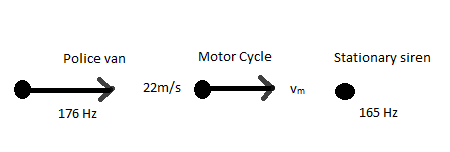
A police car moving at 22 m/s, chases a motorcyclist. The policeman sounds his horn at 176 Hz, while both of them move towards a stationary siren of frequency 165 Hz as shown in the figure. If the motorcyclist does not observe any beats, his speed must be: (take the speed of sound = 330 m/s)

A) 33 m/s
B) 22 m/s
C) zero
D) 11 m/s
Answer
222.9k+ views
Hint: Frequency is defined as the number of waves that pass through a fixed point in the unit of time. It is also defined as the number of oscillations per unit of time. The unit of frequency is Hertz.
Complete step by step solution:
Given data:
Speed of a police car, ${v_s} = 22m/s$
Frequency of the sound horn, ${n_{car}} = 176Hz$
Frequency of the siren, ${n_{siren}} = 165Hz$
Speed of the sound, v = 330 m/s
Speed of the motorcyclist, ${v_m}$ =?
It is given that in the first case the police car which is a source of sound is moving at a speed ${v_s}$and is approaching a motorcycle (observer) which in turn is moving away from the police car with a speed of ${v_m}$.
Thus the apparent frequency of the sound heard by the motorcyclist is given by,
$\Rightarrow n' = {n_{car}}\left( {\dfrac{{v - {v_m}}}{{v - {v_s}}}} \right)\_\_\_\_\_\_\_\left( 1 \right)$
Again in the second case the motorcyclist, an observer is approaching a stationary siren, source at a speed of ${v_m}$
Thus the apparent frequency of the sound heard by the motorcyclist is given by,
$\Rightarrow n'' = {n_{siren}}\left( {\dfrac{{v + {v_m}}}{v}} \right)\_\_\_\_\_\_\_\left( 2 \right)$
It is given that the motorcyclist does not observe any beats and this is possible only when the difference in the frequencies heard by the motorcyclist is zero.
Thus $n' - n'' = 0$
$ \Rightarrow n' = n''$
Substituting the values of $n'$ and $n''$ from the equations 1 and 2, we get,
$\Rightarrow {n_{car}}\left( {\dfrac{{v - {v_m}}}{{v - {v_s}}}} \right) = {n_{siren}}\left( {\dfrac{{v + {v_m}}}{v}} \right)$
Thus substituting the values of ${n_{car}},{v_m},{v_s},{n_{siren}},v,$ we get
$\Rightarrow 176\left( {\dfrac{{v - {v_m}}}{{330 - 22}}} \right) = 165\left( {\dfrac{{v + {v_m}}}{{330}}} \right)$
$ \Rightarrow \left( {\dfrac{{v - {v_m}}}{{v + {v_m}}}} \right) = \dfrac{{165}}{{176}} \times \dfrac{{308}}{{330}} = \dfrac{7}{8}$
$ \Rightarrow 8v - 8{v_m} = 7v + 7{v_m}$
$ \Rightarrow 15{v_m} = v$
$ \Rightarrow {v_m} = \dfrac{v}{{15}} = \dfrac{{330}}{{15}} = 22m/s$
Thus the speed of the motorcyclist $ = 22m/s$
Hence the correct option is B.
Note: The sound source generates the sound waves and creates the vibrations in the surrounding medium. As this continues the vibrations propagate away at the speed of the sound.
Complete step by step solution:
Given data:
Speed of a police car, ${v_s} = 22m/s$
Frequency of the sound horn, ${n_{car}} = 176Hz$
Frequency of the siren, ${n_{siren}} = 165Hz$
Speed of the sound, v = 330 m/s
Speed of the motorcyclist, ${v_m}$ =?
It is given that in the first case the police car which is a source of sound is moving at a speed ${v_s}$and is approaching a motorcycle (observer) which in turn is moving away from the police car with a speed of ${v_m}$.
Thus the apparent frequency of the sound heard by the motorcyclist is given by,
$\Rightarrow n' = {n_{car}}\left( {\dfrac{{v - {v_m}}}{{v - {v_s}}}} \right)\_\_\_\_\_\_\_\left( 1 \right)$
Again in the second case the motorcyclist, an observer is approaching a stationary siren, source at a speed of ${v_m}$
Thus the apparent frequency of the sound heard by the motorcyclist is given by,
$\Rightarrow n'' = {n_{siren}}\left( {\dfrac{{v + {v_m}}}{v}} \right)\_\_\_\_\_\_\_\left( 2 \right)$
It is given that the motorcyclist does not observe any beats and this is possible only when the difference in the frequencies heard by the motorcyclist is zero.
Thus $n' - n'' = 0$
$ \Rightarrow n' = n''$
Substituting the values of $n'$ and $n''$ from the equations 1 and 2, we get,
$\Rightarrow {n_{car}}\left( {\dfrac{{v - {v_m}}}{{v - {v_s}}}} \right) = {n_{siren}}\left( {\dfrac{{v + {v_m}}}{v}} \right)$
Thus substituting the values of ${n_{car}},{v_m},{v_s},{n_{siren}},v,$ we get
$\Rightarrow 176\left( {\dfrac{{v - {v_m}}}{{330 - 22}}} \right) = 165\left( {\dfrac{{v + {v_m}}}{{330}}} \right)$
$ \Rightarrow \left( {\dfrac{{v - {v_m}}}{{v + {v_m}}}} \right) = \dfrac{{165}}{{176}} \times \dfrac{{308}}{{330}} = \dfrac{7}{8}$
$ \Rightarrow 8v - 8{v_m} = 7v + 7{v_m}$
$ \Rightarrow 15{v_m} = v$
$ \Rightarrow {v_m} = \dfrac{v}{{15}} = \dfrac{{330}}{{15}} = 22m/s$
Thus the speed of the motorcyclist $ = 22m/s$
Hence the correct option is B.
Note: The sound source generates the sound waves and creates the vibrations in the surrounding medium. As this continues the vibrations propagate away at the speed of the sound.
Recently Updated Pages
JEE General Topics in Chemistry Important Concepts and Tips

JEE Extractive Metallurgy Important Concepts and Tips for Exam Preparation

JEE Atomic Structure and Chemical Bonding important Concepts and Tips

JEE Amino Acids and Peptides Important Concepts and Tips for Exam Preparation

Electricity and Magnetism Explained: Key Concepts & Applications

JEE Energetics Important Concepts and Tips for Exam Preparation

Trending doubts
JEE Main 2026: Application Form Open, Exam Dates, Syllabus, Eligibility & Question Papers

Derivation of Equation of Trajectory Explained for Students

Hybridisation in Chemistry – Concept, Types & Applications

Understanding the Angle of Deviation in a Prism

How to Convert a Galvanometer into an Ammeter or Voltmeter

Degree of Dissociation: Meaning, Formula, Calculation & Uses

Other Pages
JEE Advanced Marks vs Ranks 2025: Understanding Category-wise Qualifying Marks and Previous Year Cut-offs

Thermodynamics Class 11 Physics Chapter 11 CBSE Notes - 2025-26

Units And Measurements Class 11 Physics Chapter 1 CBSE Notes - 2025-26

NCERT Solutions For Class 11 Physics Chapter 8 Mechanical Properties Of Solids

Motion in a Straight Line Class 11 Physics Chapter 2 CBSE Notes - 2025-26

Laws of Motion Class 11 Physics Chapter 4 CBSE Notes - 2025-26




